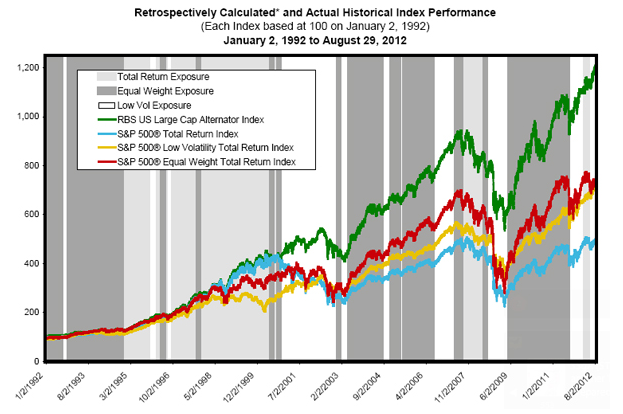On September 6, the Royal Bank of Scotland (RBS) rolled out the RBS US Large Cap Alternator ETN (ALTL). The underlying index uses a multi-period momentum strategy to provide exposure to either the S&P 500 Total Return Index, the S&P 500 Equal Weight Total Return Index, or the S&P 500 Low Volatility Total Return Index.
A “Relative Strength Score” is assigned to each of the three large cap stock weighting methodologies on the last business day of each calendar month. The calculation uses the simple average of the returns for the prior one-month, three-month, six-month, nine-month, and twelve-month periods. The ETN’s index will track the return of the weighting scheme with the highest Relative Strength Score during the following month. The monthly rebalancing takes place at the close of business on the first trading day of the month.
ALTL has an annual investor fee of 1.00%. Additional product information is available in the overview page, fact sheet (pdf), and prospectus (pdf).
Analysis/Opinion: RBS supplied hypothetical backtested results for the underlying index as part of the prospectus. The performance graph (shown below) begins 1/2/1992. Unfortunately, it uses an arithmetic scale instead of a log scale, which distorts the long-term performance characteristics, and it shows the results for the index instead of the ETN. A table is also provided, but its data begins a year later (12/31/92) and also does not adjust for the 1.00% annual investor fee.

My calculations, based on the data in the prospectus, along with a 1% annual reduction of ALTL’s underlying index to account for the investor fee, produced the following results for the period 12/31/92 – 8/29/12: The backtested ALTL ETN had an estimated +11.7% annual return with a 16.1% standard deviation. The comparative returns (and standard deviation) of the other underlying indexes were +8.3% (19.1%) for S&P 500 Total Return, +10.1% (19.3%) for Equal Weighting, and +10.0% (14.2%) for Low Volatility.
It is possible to implement this strategy on a do-it-yourself basis using Vanguard S&P 500 ETF (VOO), PowerShares S&P 500 Low Volatility (SPLV), and Guggenheim S&P 500 Equal Weight ETF (RSP). However, investors need to weigh the monthly transaction costs, tax consequences, and underlying ETF expense ratios against the 1% annual fee and inherent credit risk of ETNs like ALTL.
Disclosure covering writer, editor, and publisher: Long SPLV. No positions in any of the companies or ETF sponsors mentioned. No income, revenue, or other compensation (either directly or indirectly) received from, or on behalf of, any of the companies or ETF sponsors mentioned.